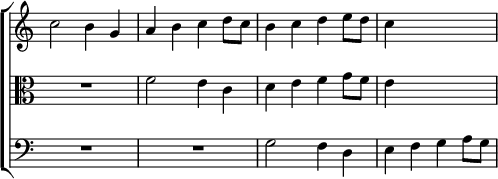three or four parts in many different ways, We give two specimens in three, and two in four parts.

Here is a simple example, in which each part follows at a distance of one bar. The intervals of entry are irregular; the alto being a fifth below the treble, and the bass a seventh below the alto.
265. In our next example,

the intervals of entry are the same as in the last; but a quite different effect is produced, because now the answer leads and the subject replies; and, besides this, the distance of time in the entries is irregular, the second voice being two bars later than the first, and the third voice only one bar later than the second.
266. In our first four-part example,

the entries are regular as regards distance of time (one bar), but irregular as to interval. In this stretto it is not possible in any of the voices (except, of course, the bass which is the last to enter, and in which it should be complete—§ 252) to continue the subject to any great length.
